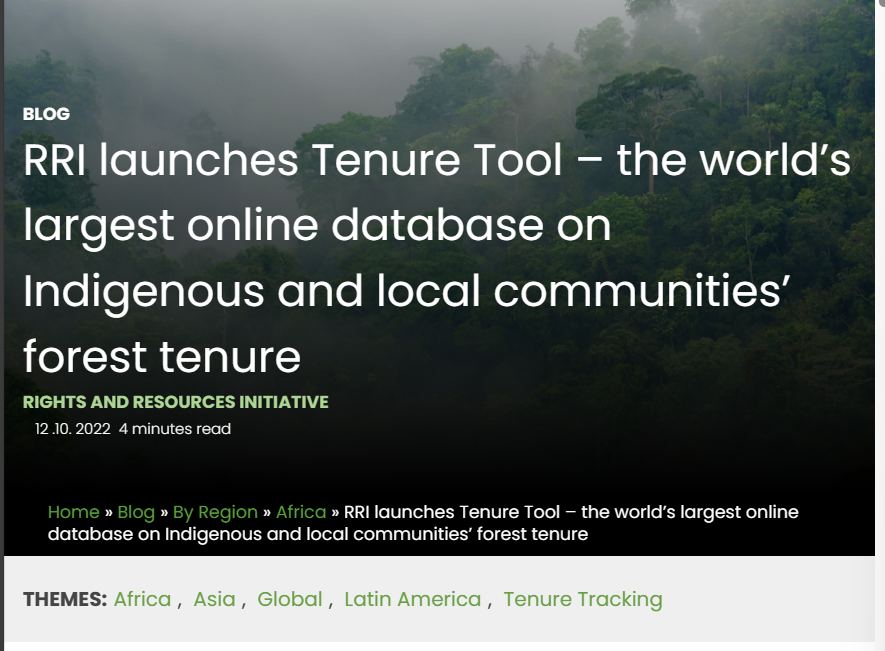RRI is excited to announce the launch of its new online Tenure Tool. This platform, hosted on RRI’s website, will give rightsholders, researchers, activists, policymakers, and the public free and easy access to qualitative and quantitative data on the forest tenure rights of Indigenous Peoples, Afro-descendant Peoples, local communities, and the women within those communities.
The Tenure Tool houses the largest and most comprehensive dataset to date on Indigenous, Afro-descendant, and local communities’ forest tenure rights, drawing on longitudinal data sets maintained and regularly updated by RRI.
Why do we need this tool?
For almost two decades, RRI has sought to fill gaps in the available data on the extent of Indigenous Peoples’, Afro-descendant Peoples’, local communities’, and women’s land, forest, and resource tenure rights. Historically, sources of data on land and forest ownership were sparsely and disparately available across countries, often relying on varying methods that only considered community tenure to varying degrees. In this context, RRI began systematically aggregating and analyzing available data on the distribution of forest tenure rights from government, academic, and civil society sources from its founding and now tracks who owns and manages 92% of global forest area.
In the past 10 years, the ecosystem of RRI data has expanded far beyond tracking the area of recognized community forests. Our latest methodologies are designed to monitor the specific legal entitlements held by communities and women within communities to their lands, forests, and freshwaters under national law. For 30 countries in Africa, Asia, and Latin America, RRI tracks and analyzes the strength of communities’ legally recognized rights—what we call the “depth of rights”—as well as women’s statutory rights within their communities, and the number of countries included in this database continues to grow.
As this data ecosystem has grown and flourished, it has inevitably become more complex to navigate. Our goal, of course, is for the data to be useful, and to support targeted research and advocacy at national and international levels. The new Tenure Tool is, as the name suggests, a tool to make these data more usable.
All of the data housed in this new platform have previously been published in various RRI analyses, including At a Crossroads and Power and Potential. But this platform, for the first time, serves to aggregate global, regional, and country level information pertaining to the strengths, weaknesses, extent, and gender sensitivity of legal frameworks recognizing Indigenous, Afro-descendant, and local communities’ forest tenure rights in one interactive tool.
Watch our quick explainer video to learn about how to use this tool.
The new Tenure Tool improves the accessibility and usability of RRI’s forest tenure data in several ways:
- It now allows users interested in a specific country or region to access multiple types of legal and area-based forest tenure data for that country or region on one page, instead of having to consult multiple reports.
- It brings together data across RRI’s globally comparative frameworks for assessing community tenure rights. This means users at all levels can easily rely on a common reference point to monitor a range of critical indicators and use this information in their advocacy;
- It allows users to view all legal frameworks recognizing community-based tenure within a given country, and compare them side-by-side;
- It also provides a mechanism for reporting against the UN Sustainable Development Goal indicators, in particular Indicator 5.a.2 in the context of women rightsholders within communities.
This platform is the product of an ongoing effort to enhance comparability and facilitate learning across RRI’s many datasets. Its production has been an extensive multi-year process undertaken by RRI’s researchers that first required taking stock of all the data collected across RRI’s various databases. The next step involved standardizing, collating, and integrating data from multiple separate legal data sets into a single, easy to navigate database. Next, we worked with our web developer, Bracket Media, to develop a code for interpreting and visualizing this data.
All the data presented in the Tenure Tool were peer reviewed by country experts, and each dataset is the product of a rigorous analysis that incorporates qualitative and quantitative methods. It is important to note that RRI updates all of its data on rotating cycles and the Tenure Tool will be updated to showcase new information as it becomes available.

